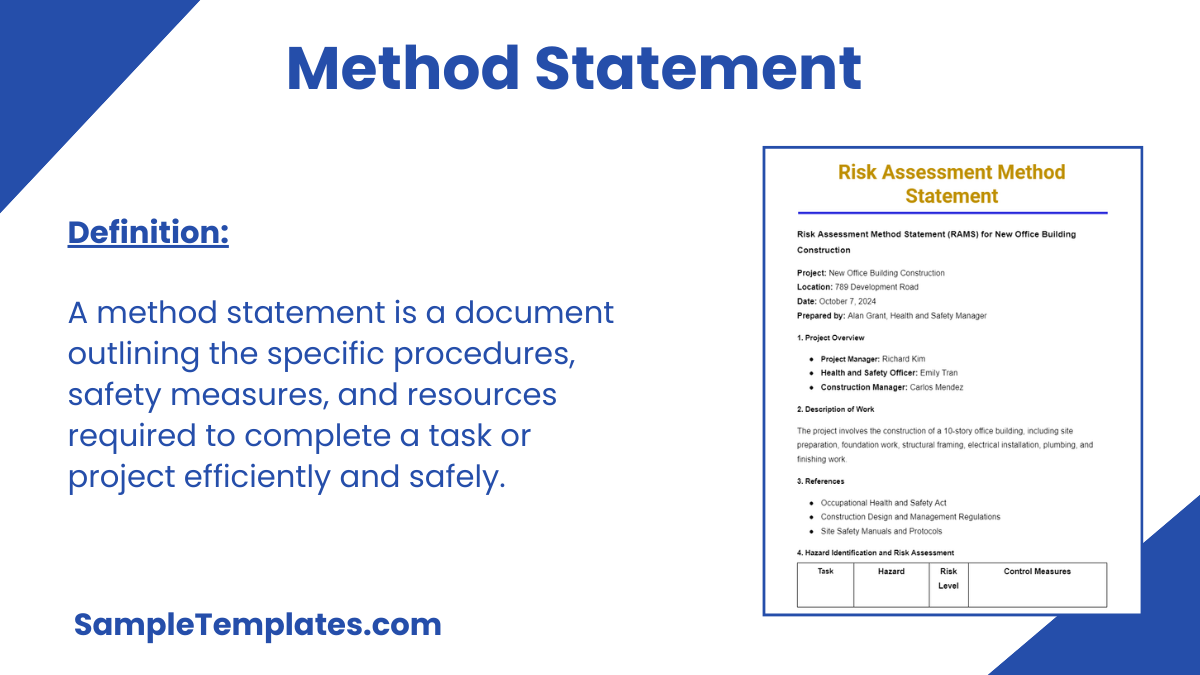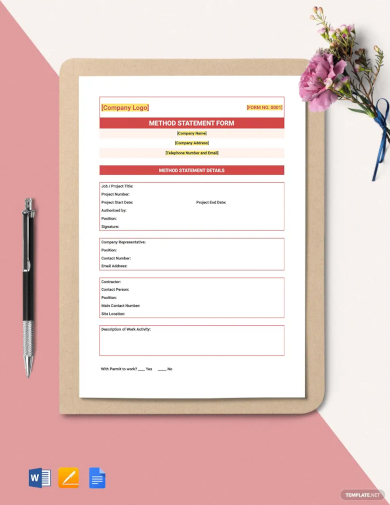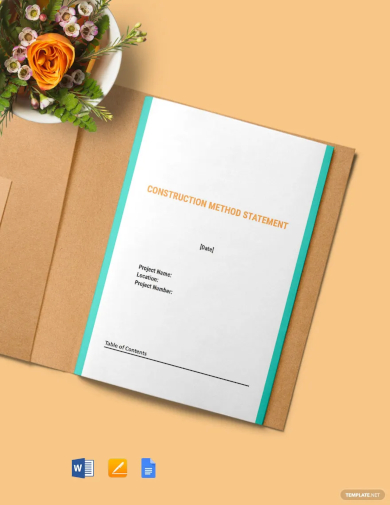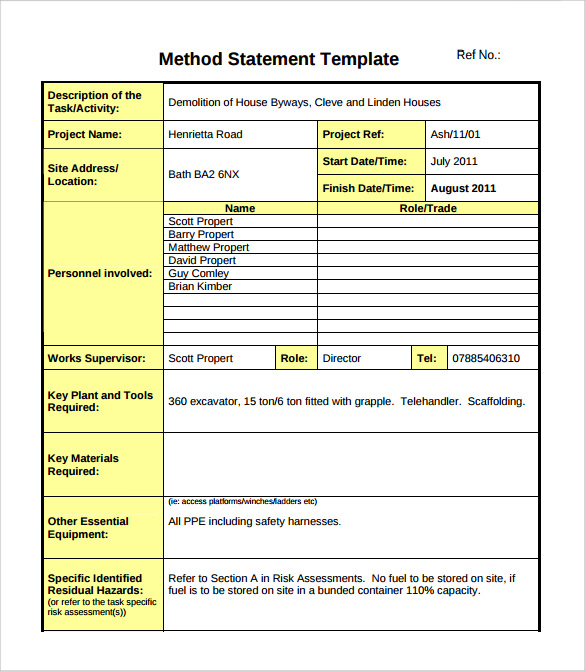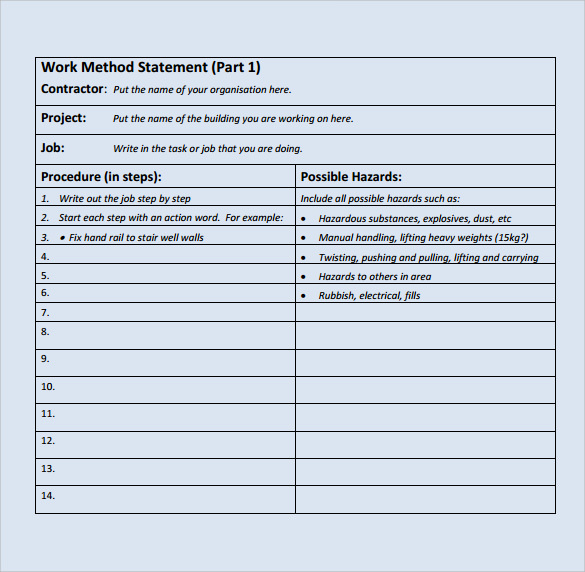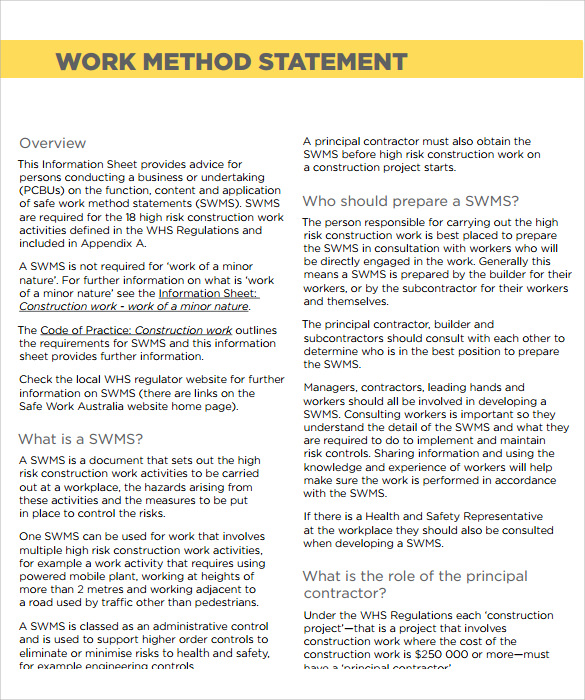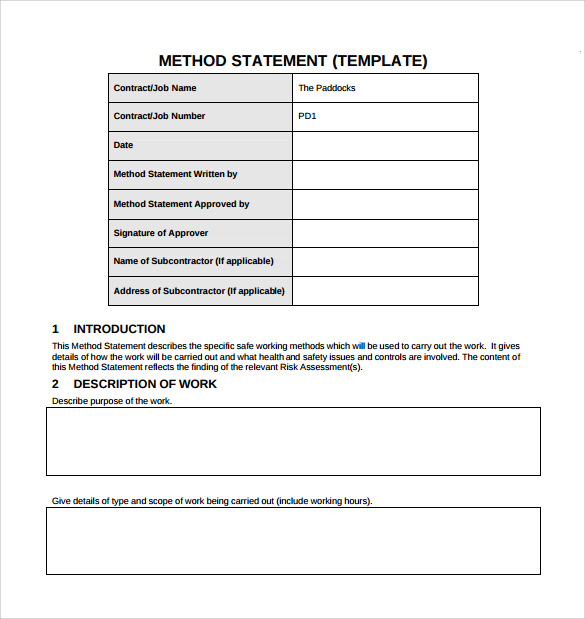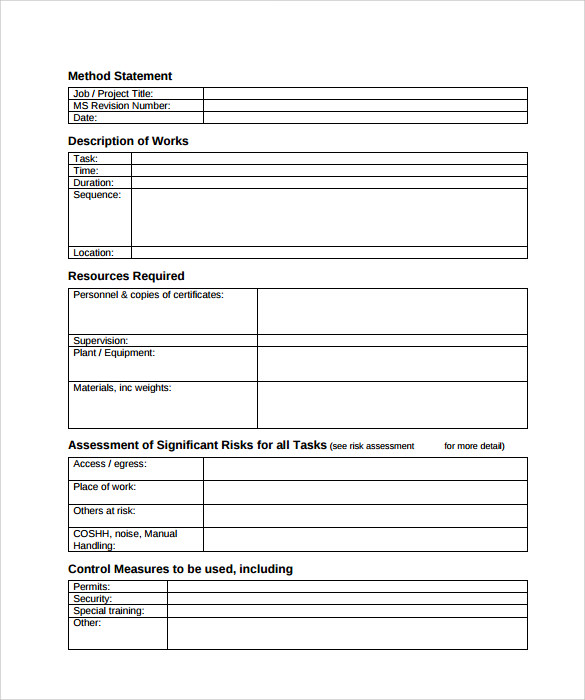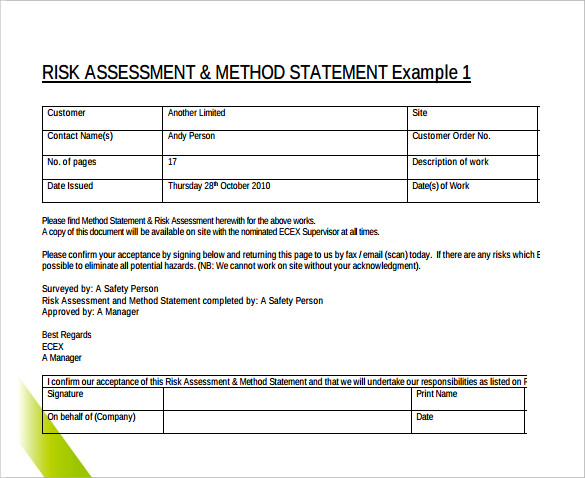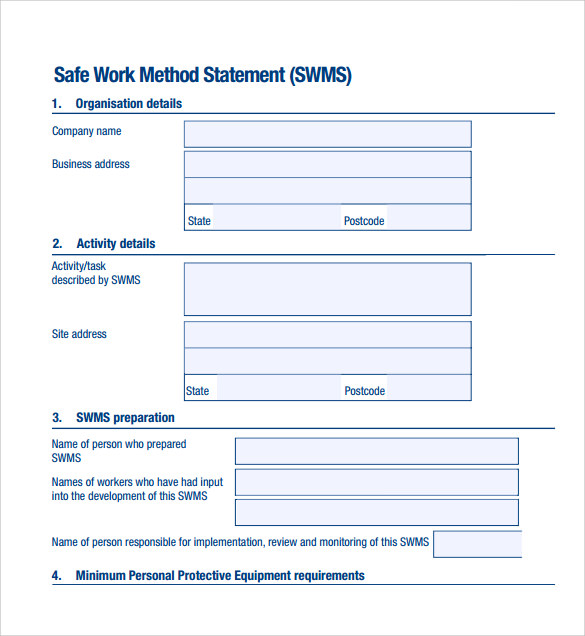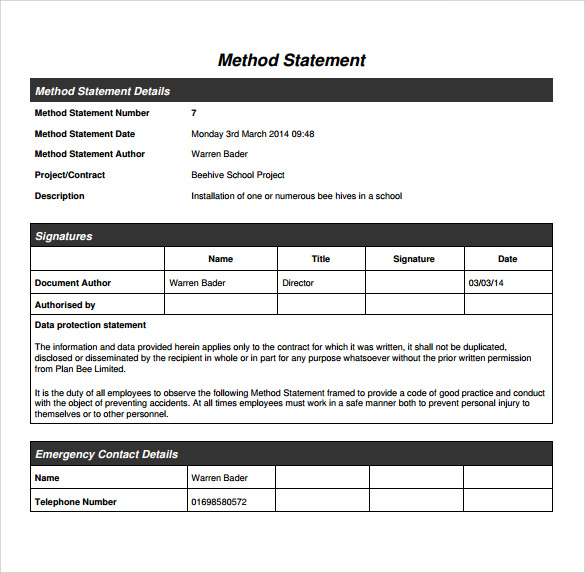Method statement is the safe system procedure which is usually seen in construction projects in order to perform the project fully while maintaining the safety of all personnel and people around the construction site. This presenting tool is prepared by the contractor to have a backup sample plan when unexpected event happen in the site that may pose risk or danger to the employee or people around the site. You may also see bank statements.
The example you need like this can be seen for free online, you can download the applicable document for your use; Microsoft word can also give you a helping hand in making your own method statement where you can save and print the file when you are done. Method statement templates is a vital plan of procedure to avoid any unnecessary accidents or danger in the construction area.
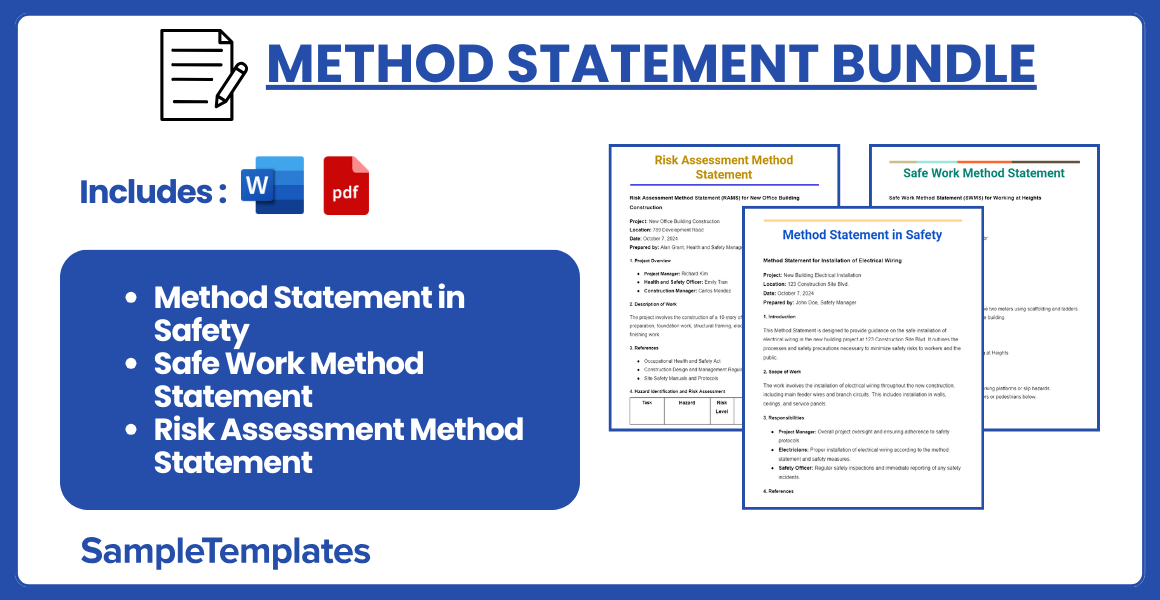
Download Method Statement Bundle
Method Statement in Safety
Method Statement for Installation of Electrical Wiring
Project: New Building Electrical Installation
Location: 123 Construction Site Blvd.
Date: October 7, 2024
Prepared by: John Doe, Safety Manager
1. Introduction
This Method Statement is designed to provide guidance on the safe installation of electrical wiring in the new building project at 123 Construction Site Blvd. It outlines the processes and safety precautions necessary to minimize safety risks to workers and the public.
2. Scope of Work
The work involves the installation of electrical wiring throughout the new construction, including main feeder wires and branch circuits. This includes installation in walls, ceilings, and service panels.
3. Responsibilities
- Project Manager: Overall project oversight and ensuring adherence to safety protocols.
- Electricians: Proper installation of electrical wiring according to the method statement and safety measures.
- Safety Officer: Regular safety inspections and immediate reporting of any safety incidents.
4. References
- Local Electrical Code
- Health and Safety at Work Act
- Company Safety Protocol Manual
5. Description of Activities
- Site Preparation: Clearing pathways, marking installation areas, and establishing emergency exits.
- Installation: Measuring, cutting, and installing wires; installing conduits and associated fixtures; testing connections.
- Inspection and Testing: Regular checks during installation by the Safety Officer to ensure compliance with safety standards.
6. Safety Hazards and Risk Assessment
- Electrical Shock: Use of insulated tools, gloves, and appropriate PPE.
- Falls from Height: Use of secure ladders and, if necessary, harness systems when working at height.
- Cuts and Abrasions: Use of protective clothing and careful handling of tools and materials.
7. Safety Precautions
- All electricians must be certified and trained in electrical safety and first aid.
- Regular toolbox talks to reinforce safety measures.
- Clear marking of all work areas to prevent unauthorized access.
- Emergency medical kit available on site at all times.
8. Personal Protective Equipment (PPE)
- Electrical Gloves
- Safety Glasses
- Hard Hats
- Protective Footwear
9. Emergency Procedures
- Immediate shutdown procedures for electrical systems.
- Evacuation routes and assembly points clearly marked and communicated.
- Emergency contact numbers displayed at multiple locations on the site.
10. Monitoring and Review
This Method Statement will be reviewed weekly by the project team to ensure its effectiveness and updated in response to any changes in the project scope or working methods.
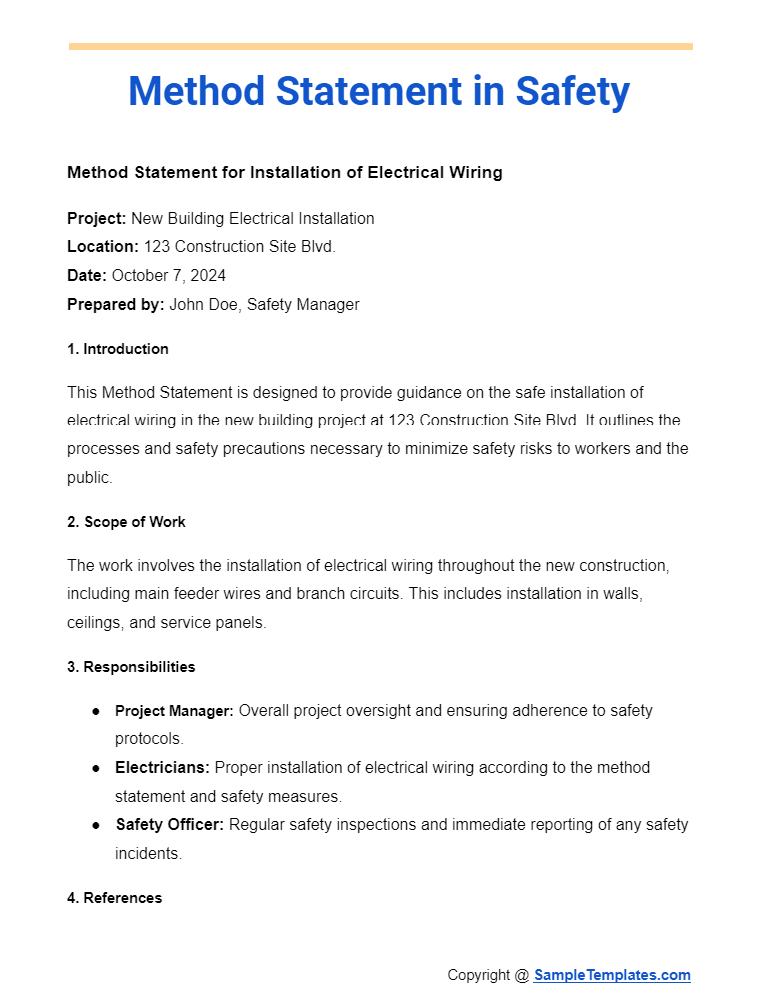
Safe Work Method Statement
Safe Work Method Statement (SWMS) for Working at Heights
Project: High Rise Construction Project
Location: 456 High Tower Lane
Date: October 7, 2024
Prepared by: Jane Smith, Safety Coordinator
1. Project Details
- Project Manager: James Anderson
- Site Supervisor: Sarah Lee
- Safety Officer: Michael Roberts
2. Activity Description
The activity involves working at heights above two meters using scaffolding and ladders to install external cladding on a new high-rise building.
3. Legislation and Standards
- Work Health and Safety Act
- National Code of Practice for Working at Heights
- Company Health and Safety Policy
4. Identification of Hazards
- Falls from heights due to unstable working platforms or slip hazards.
- Falling objects that could injure workers or pedestrians below.
- Weather conditions that may compromise safety on scaffolding (e.g., high winds, rain).
5. Risk Assessment
- Falls: Risk level is high. Potential for serious injury or fatality.
- Falling Objects: Risk level is moderate to high. Potential for injury to persons below work area.
- Adverse Weather: Risk level is moderate. Could lead to slips or loss of control.
6. Control Measures
- Falls:
- Only trained personnel allowed to work at heights.
- Use of fall arrest systems, including harnesses and safety nets.
- Regular inspection and maintenance of all scaffolding.
- Falling Objects:
- Use of toe boards and tool lanyards to prevent tools and materials from falling.
- Mandatory hard hats for everyone in the vicinity.
- Weather Conditions:
- Monitoring of weather updates via local weather service.
- Suspension of work during high winds or electrical storms.
7. Personal Protective Equipment (PPE)
- Safety harnesses and lanyards for all workers working at heights.
- Hard hats, safety boots, and high visibility clothing for all site personnel.
- Gloves and eye protection as required by task specifics.
8. Training and Competency
- All workers must have completed a recognized safety training program specific to working at heights.
- Regular refresher training courses to be attended by all site workers.
9. Emergency Procedures
- Detailed rescue plan in place for fall incidents, including on-site rescue equipment and trained personnel.
- Immediate reporting procedures for all incidents and near-misses.
- Emergency contact information readily accessible to all workers.
10. Review and Monitoring
- Weekly safety inspections by the Safety Officer to ensure ongoing compliance with the SWMS.
- SWMS to be reviewed and updated following any incident or introduction of new work methods or equipment.
11. Worker Agreement
- All workers involved in this task must read and sign this SWMS to acknowledge understanding and acceptance of the risks and controls.
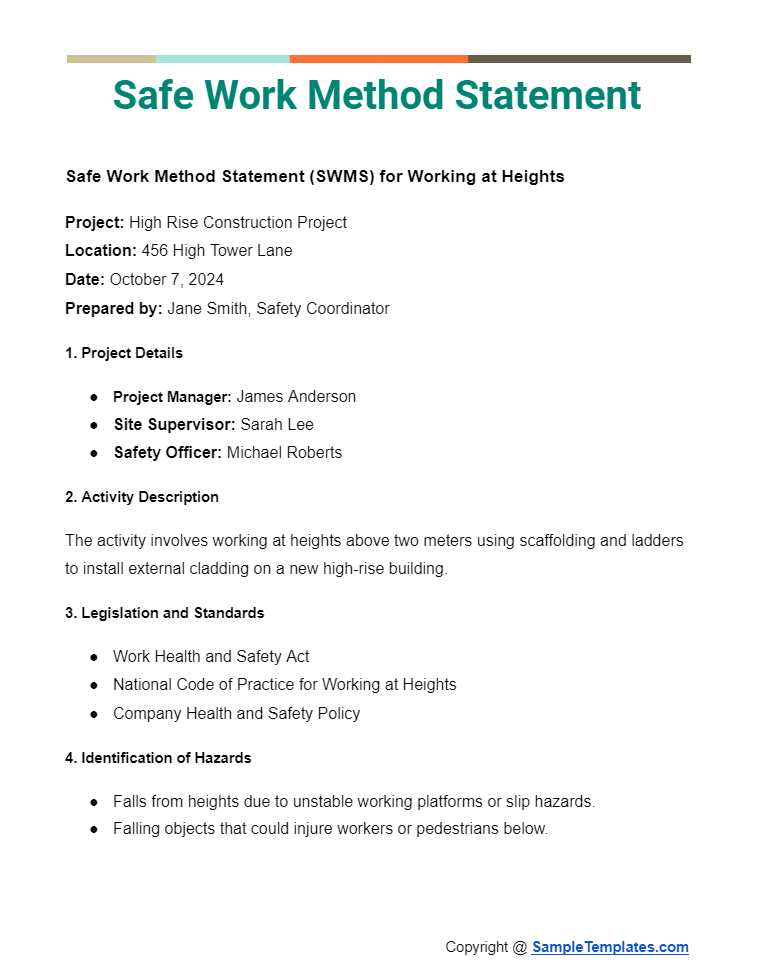
Risk Assessment Method Statement
Risk Assessment Method Statement (RAMS) for New Office Building Construction
Project: New Office Building Construction
Location: 789 Development Road
Date: October 7, 2024
Prepared by: Alan Grant, Health and Safety Manager
1. Project Overview
- Project Manager: Richard Kim
- Health and Safety Officer: Emily Tran
- Construction Manager: Carlos Mendez
2. Description of Work
The project involves the construction of a 10-story office building, including site preparation, foundation work, structural framing, electrical installation, plumbing, and finishing work.
3. References
- Occupational Health and Safety Act
- Construction Design and Management Regulations
- Site Safety Manuals and Protocols
4. Hazard Identification and Risk Assessment
| Task | Hazard | Risk Level | Control Measures |
|---|---|---|---|
| Site Preparation | Injury from machinery | High | Only trained personnel to operate machinery; PPE usage. |
| Excavation | Collapse of excavation site | High | Shoring and sloping of excavation sides; regular inspections. |
| Concrete Pouring | Skin irritation from concrete | Medium | Use of gloves and protective clothing; eye wash stations. |
| Working at Height | Falls | High | Installation of guardrails; use of harnesses. |
| Electrical Work | Electrical shock | High | Lockout-tagout systems; qualified electricians only. |
| Finishing Work | Dust inhalation | Medium | Dust control measures; use of respirators. |
5. Method Statement
- Site Preparation: Clear site, establish access routes, and set up site office.
- Foundation Work: Excavate for foundations, install formwork, place rebar, and pour concrete.
- Framing: Construct structural frame using steel beams and columns.
- Electrical and Plumbing: Install systems as per engineering designs.
- Finishing: Plastering, painting, installation of fixtures, and final inspections.
6. Safety Precautions
- Regular safety briefings and training for all site workers.
- Mandatory use of PPE including helmets, gloves, boots, and high-visibility jackets.
- Clear signage and barriers around high-risk areas such as excavation sites and heights.
7. Personal Protective Equipment (PPE)
- Full-body harnesses for work at heights.
- Goggles, gloves, and protective clothing for concrete work.
- Ear protection for work involving high noise levels.
8. Emergency Procedures
- On-site first aid kits and trained first aid responders.
- Clear evacuation routes and assembly points.
- Emergency contact numbers posted throughout the site.
9. Monitoring and Review
- Daily safety inspections by the site safety officer.
- Weekly safety audits and review meetings with the project team.
- Updates to RAMS document as necessary following incident reviews or procedural changes.
10. Worker Acknowledgment
- All workers are required to read and acknowledge understanding of this RAMS by signing off before commencing work.
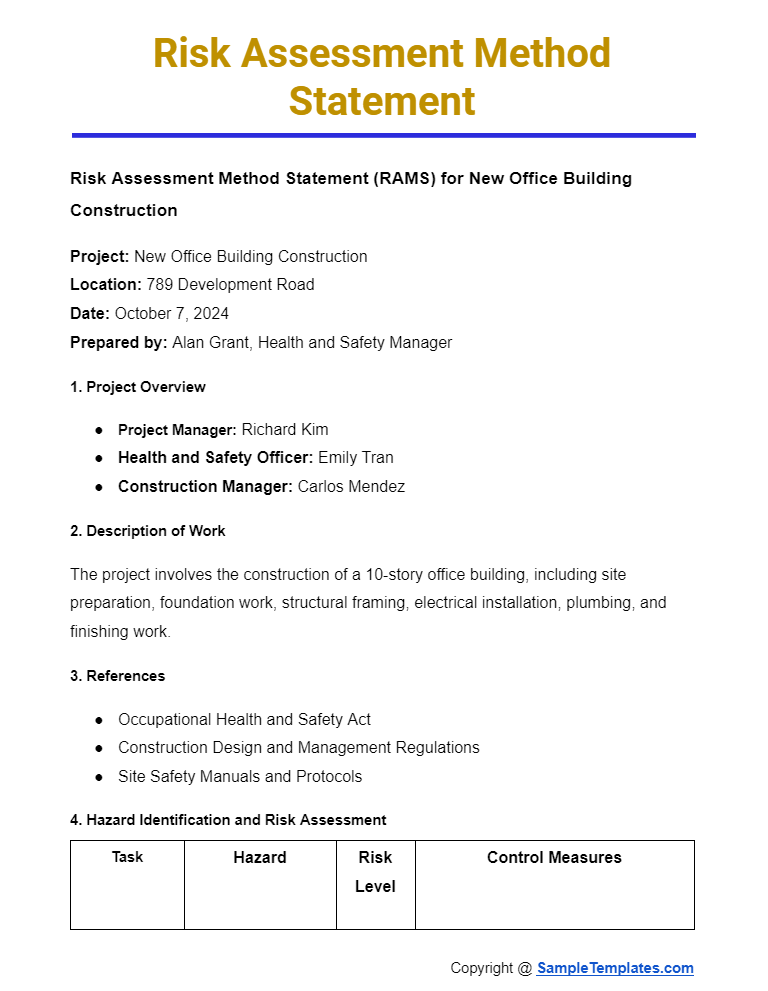
Browse More Templates On Method Statement
Method Statement Template Word
Construction Method Statement Template Word
Method Of Statement Sample
Method Of Statement Template
Tips For Creating an Effective Method Statement
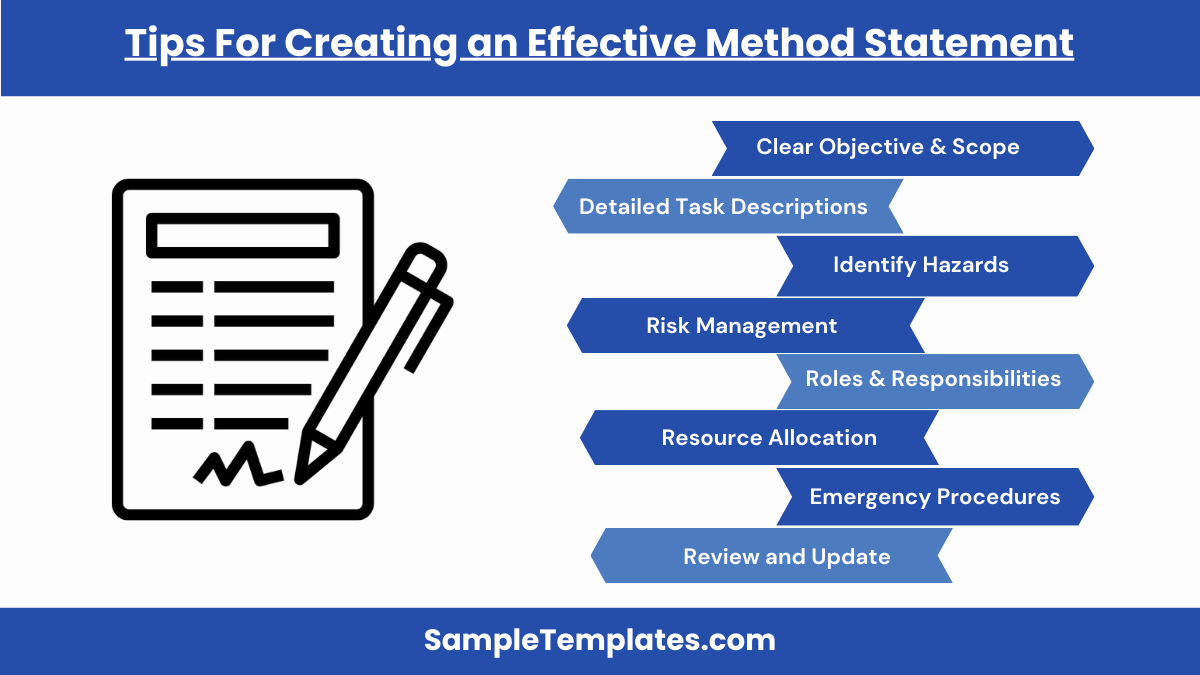
- Clear Objective and Scope: Start by defining the objective and scope of the work clearly. Describe the specific tasks and outcomes expected. This helps everyone involved understand what needs to be achieved and the extent of the work. You can also see more on Construction Method Statement.
- Detailed Task Descriptions: Break down the work into individual tasks or stages. Describe each step in detail, ensuring that the process is easy to understand and follow. Include information about the sequence of operations and the technical details necessary to complete each task safely.
- Identify Hazards: Conduct a thorough risk assessment for each task or stage. Identify potential hazards that could arise during the execution of the work. This could include environmental hazards, equipment-related risks, or risks related to manual handling.
- Risk Management: For each hazard identified, specify the control measures that will be implemented to mitigate risks. This includes safety equipment, work procedures, or any monitoring activities to ensure the effectiveness of the control measures. You can also see more on Work Method Statement.
- Roles and Responsibilities: Clearly define the roles and responsibilities of all team members involved in the tasks. Ensure that each person knows their specific duties and how they contribute to the safety and efficiency of the project.
- Resource Allocation: Detail the resources and equipment needed for each stage of the work. This includes materials, tools, and personal protective equipment (PPE). Ensuring that all necessary resources are available can prevent delays and potential safety issues.
- Emergency Procedures: Outline the emergency response procedures related to the tasks. This should include steps to take in case of an accident, emergency contact numbers, and locations of first aid and firefighting equipment. You can also see more on Electrical Method Statement.
- Review and Update: Method Statements should not be static documents. Regularly review and update them to reflect any changes in the work environment, task requirements, or legislation. Encourage feedback from the team to improve the statement’s effectiveness.
Method Statement Template Free
Simple Method Statement Template
Method Statement Sample PDF
Method Statement PDF Free Download
Method Statement Example
What is Method Statement For Engineering Works?
A method statement for engineering works is a document that outlines the detailed procedures, methodologies, and sequences of activities to be followed during the execution of specific engineering tasks or projects. It serves as a comprehensive guide to ensure that the work is carried out safely, efficiently, and in accordance with established standards and regulations. Here are key components typically included in a method statement for engineering works:
- Title and Project Information: Clearly state the title of the method statement and provide details about the project, including location, date, and project reference numbers.
- Objective: Define the specific objectives of the engineering works and what is expected to be achieved.
- Scope of Work: Detail the scope of the engineering activities, specifying the tasks, phases, and areas covered by the method statement. You can also see more on Risk Assessment Method Statement.
- Project Organization: Outline the organizational structure for the project, including roles and responsibilities of key personnel.
- Work Procedures: Provide step-by-step procedures for each task, highlighting the sequence of activities, necessary equipment, materials, and resources.
- Health and Safety Measures: Emphasize health and safety considerations, including risk assessments, protective measures, and compliance with safety regulations.
- Quality Control and Assurance: Describe the quality control and assurance measures to be implemented, ensuring that the work meets specified standards and requirements.
- Environmental Considerations: Address any environmental impact concerns and detail measures to mitigate and manage environmental risks. You can also see more on Safe Work Method Statement.
- Monitoring and Inspection: Define the monitoring and inspection protocols, specifying how the work will be supervised and evaluated for compliance.
- Emergency Procedures: Clearly outline emergency procedures and contingency plans in case of unexpected events or incidents.
- Testing and Commissioning: Detail the procedures for testing and commissioning, ensuring that the completed work meets the required standards and specifications.
- Documentation: Specify the documentation requirements, including record-keeping, reports, and any other relevant paperwork. You can also see more on Health And Safety Method Statement.
- Approval and Sign-Off: Include a section for approvals and sign-offs, indicating the responsible parties and the process for obtaining authorization to proceed with the work.
A well-prepared method statement is essential for managing risks, ensuring compliance, and achieving successful outcomes in engineering projects. It provides a roadmap for all stakeholders involved in the project, fostering clarity, accountability, and adherence to best practices.
Work Method Statement Template
How is a Method Statement Used?
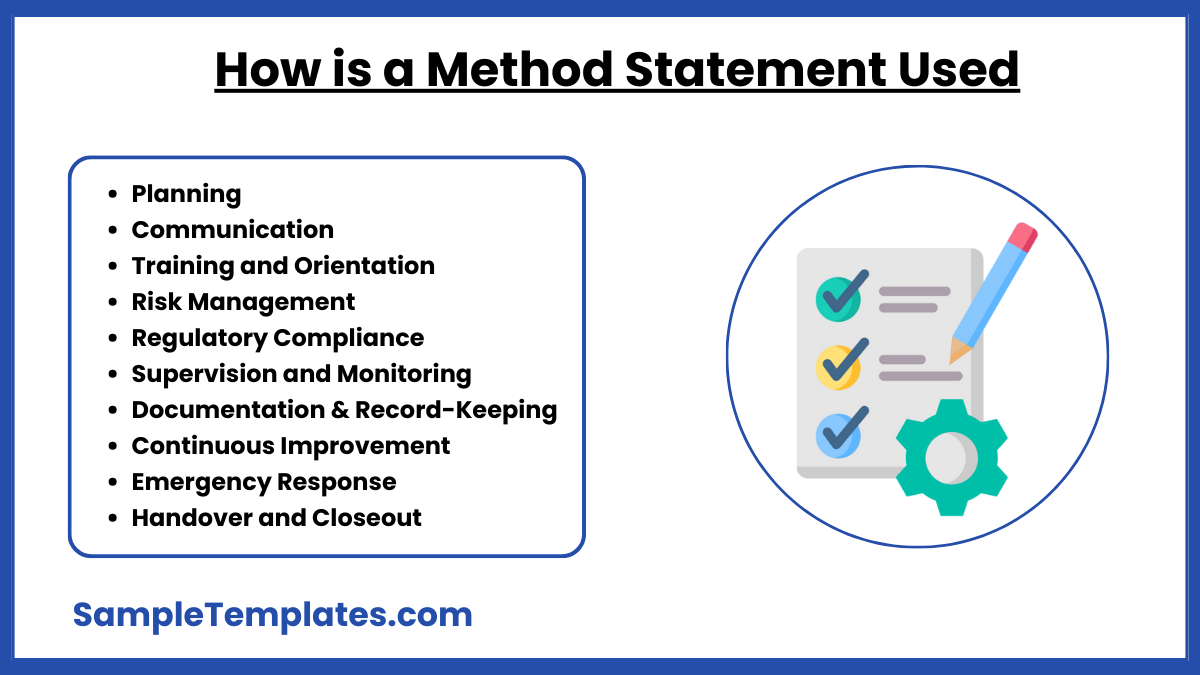
A method statement is a crucial document used in engineering and construction projects to ensure that work is carried out safely, efficiently, and in accordance with established procedures. Here’s how a method statement is typically used:
- Planning: During the sample planning phase of a project, the method statement is developed to outline the step-by-step procedures for executing specific tasks. It helps project managers, engineers, and workers understand the sequence of activities and the resources required.
- Communication: The method statement serves as a communication tool, conveying important information about the scope of work, work procedures, safety measures, and other critical aspects. It is distributed to all relevant stakeholders, including site workers, supervisors, and safety officers.
- Training and Orientation: The document is used for training and orienting personnel involved in the project. It ensures that everyone understands the correct procedures, safety precautions, and quality standards associated with their tasks.
- Risk Management: A method statement includes risk assessments and mitigation measures. It is used to identify potential hazards and implement preventive actions to minimize risks. This proactive approach contributes to a safer working environment.
- Regulatory Compliance: The method statement helps ensure compliance with local regulations, industry standards, and project specifications. It outlines the legal and procedural requirements that must be followed during the execution of the work.
- Supervision and Monitoring: Supervisors and project managers use the method statement to monitor work progress. They can ensure that activities are carried out as planned and intervene if deviations occur. The document also facilitates regular inspections and audits.
- Documentation and Record-Keeping: The method statement is a key part of project documentation. It provides a record of the planned procedures, safety measures, and quality control processes. This documentation is valuable for project audits, reviews, and future reference.
- Continuous Improvement: After the completion of tasks, the method statement is often reviewed to identify areas for improvement. Lessons learned during the project can be documented, and the method statement can be updated for future projects.
- Emergency Response: In the event of unforeseen circumstances or emergencies, the method statement includes emergency procedures. This information guides personnel on how to respond to emergencies and ensures a coordinated and effective response. You can also see more on Risk Analysis.
- Handover and Closeout: When a project is completed, the method statement serves as part of the documentation for handover and closeout. It provides a comprehensive record of the procedures followed during the project’s lifecycle.
Method Statement Format
What is a Method Statement and How to Write Them?
If you have any DMCA issues on this post, please Contact us!
Related Posts
Sample Business Card Templates
Sample Cashier Job Descriptions
Questionnaire Samples
FREE 10+ Sample HR Resource Templates in PDF
FREE 10+ HR Consulting Business Plan Samples in MS Word | Google Docs | Pages | PDF
FREE 49+ Sample Job Descriptions in PDF | MS Word
FREE 16+ Nonprofit Budget Samples in PDF | MS Word | Excel | Google Docs | Google Sheets | Numbers | Pages
FREE 13+ Academic Calendar Templates in Google Docs | MS Word | Pages | PDF
FREE 10+ How to Create an Executive Summary Samples in Google Docs | MS Word | Pages | PDF
FREE 23+ Sample Event Calendar Templates in PDF | MS Word | Google Docs | Apple Pages
Company Profile Samples
FREE 10+ Leadership Report Samples [ Development, Training, Camp ]
FREE 24+ Sample Payment Schedules in PDF | MS Word
FREE 10+ Return to Work Action Plan Samples in PDF | DOC
Autobiography Samples & Templates
